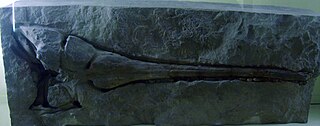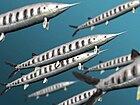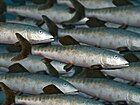Pholidophorus is an extinct genus of stem-teleost fish. Numerous species were assigned to this genus in the past, but only the type species Pholidophorus latiusculus, from the Late Triassic of Europe, is considered to be a valid member of the genus today.

Leptolepis is an extinct genus of stem-teleost fish that lived in what is now Europe during the Jurassic period.
Gyrosteus is an extinct genus of very large ray-finned fish belonging to the family Chondrosteidae. It comprises the type species, Gyrosteus mirabilis, which lived during the early Toarcian in what is now northern Europe. A possible second species, "Gyrosteus" subdeltoideus, is known from otoliths.
Aetheolepis is an extinct genus of ray-finned fish which lived in freshwater environments in what is now Western Australia and New South Wales during the Jurassic period. It contains one species, A. mirabilis. Aetheolepis was previously thought to be an archaeomaenid, until a 2016 study instead recovered it as a member of the family Dapediidae. Like other dapediids, it had a deep, discoid-shaped body. Fossils of A. mirabilis have been found in the Talbragar River fossil beds of New South Wales and the Colalura Sandstone of Western Australia. It was named by Arthur Smith Woodward in 1865 along with other Talbragar fish.

Acrolepis is an extinct genus of prehistoric bony fish that lived from the Tournaisian stage of the Mississippian to the late Permian epoch. Some species from the Early Triassic of Tasmania are also ascribed to Acrolepis.
Scanilepis is an extinct genus of prehistoric bony fish that lived during the Rhaetian-Hettangian stages. The type species, S. dubia, is known from the Rhaetian freshwater deposits of the Bjuv member of the Höganäs Formation, southwestern Sweden. A second species, S. spitzbergensis was described from the Hettangian of the Festning section of the Grøfjorden area in Spitsbergen, Norway. This fish was originally identified as a member of the genus Gyrolepis, as Gyrolepis dubius, being latter assigned to it´s own genus and classified as a member of Palaeonisciformes. Latter works placed it as a taxon close to the origin of the family Amiidae, until was found latter to belong to it´s own family (Scanilepididae) and order, Scanilepiformes. Regarding to the microstructure of its scales, Scanilepis approaches the condition of Polypterus or Erpetoichthys more than any other genera.
Ankylophorus is an extinct genus of stem-teleost ray-finned fish that lived in what is now France during the Late Jurassic. Its type and only species, Ankylophorus similis, was originally named in 1895 as a species of Pholidophorus, but was moved to a separate genus in 1978.
Athrodon is an extinct genus of pycnodontid that lived in shallow seas in what is now England and France from the Late Jurassic until the genus extinction during the start of the late Cretaceous. The various species are very similar in splenial bone and tooth morphology to Mesodon. Otherwise, no articulated or complete specimen is known: all fossil specimens are bone fragments and disarticulated teeth.

Boreosomus is an extinct genus of Triassic ray-finned fish. It was first described from the Arctic island of Spitsbergen, but was later also discovered in other parts of the world. Boreosomus belongs to the family Ptycholepidae. Other genera of this family are Acrorhabdus (Spitsbergen), Ardoreosomus, Chungkingichthys (China), Ptycholepis (global) and Yuchoulepis (China).

Coccolepis is an extinct genus of prehistoric ray-finned fish in the family Coccolepididae. Originally including most species within the family, it is now restricted to two species from the Late Jurassic Solnhofen Limestone of Germany. The holotype of C. bucklandi, designated and described by Louis Agassiz, was thought to be lost but was later rediscovered in Neuchâtel.

Prohalecites is an extinct genus of ray-finned fish from the Ladinian and possibly Carnian (Triassic) of Italy. It is the oldest known teleosteomorph, a group that includes extant teleosts and their close fossil relatives.

Orthocormus is an extinct genus of prehistoric pachycormiform bony fish. It is known from three species found in Late Jurassic (Kimmeridgian) aged plattenkalk deposits in Bavaria, Germany. The species "Hypsocormus" tenuirostris Woodward 1889 from the late Middle Jurassic (Callovian) Oxford Clay is not closely related to the type species of Hypsocormus, and is more closely related to Orthocormus + Protosphyraena, and thus has sometimes been referred to in open nomenclature as Orthocormus? tenuirostris.

Morrolepis is an extinct genus of prehistoric coccolepidid "palaeoniscoid" ray-finned fish that lived during the Late Jurassic and earliest Cretaceous epochs in Europe, Asia and North America.

Pholidosaurus is an extinct genus of neosuchian crocodylomorph. It is the type genus of the family Pholidosauridae. Fossils have been found in northwestern Germany. The genus is known to have existed during the Berriasian-Albian stages of the Early Cretaceous. Fossil material found from the Annero and Jydegård Formations in Skåne, Sweden and on the island of Bornholm, Denmark, have been referred to as a mesoeucrocodylian, and possibly represent the genus Pholidosaurus.

Saurichthyiformes is an extinct order of ray-finned fish which existed in Asia, Africa, Australia, Europe and North America, during the late Permian to early Middle Jurassic. Saurichthyiiformes comprise two families, Saurichthyidae and Yelangichthyidae. Whereas Yelangichthyidae is monotypic, Saurichthyidae includes at least two genera, Saurorhynchus and the very speciose Saurichthys. Additionally, the subgenera Costasaurichthys, Eosaurichthys, Lepidosaurichthys, and Sinosaurichthys are frequently used to group species. Saurichthyiforms were highly successful predators, and with Yelangichthys possibly even included durophagous forms. Species are known from both marine end freshwater deposits. They had their highest diversity during the Early and Middle Triassic.

Tarasiiformes is an extinct order of prehistoric ray-finned fish.

Bobasatraniiformes is an extinct order of durophagous ray-finned fish that existed from the late Permian to the Middle Triassic in both marine and freshwater environments. The order includes two families: Bobasatraniidae, with the genera Bobasatrania, Ebenaqua, and Ecrinesomus, and Dorypteridae, comprising only the genus Dorypterus (monotypy). Bobasatraniiformes had a somewhat global distribution; fossils are found in Africa (Madagascar), Asia (Pakistan), Australia, Europe, and North America.

Acrolepididae is an extinct family of ray-finned fish. Genera referred to Acrolepididae existed from the Early Carboniferous period to the Early Triassic epoch. They were nektonic carnivores with a fusiform body.

Dorsetichthys is an extinct genus of stem-teleost ray-finned fish from the Early Jurassic period of Europe.

Pholidophoridae is an extinct family of primitive stem-teleost fish that lived during the Triassic period. Most of the genera are from the Late Triassic of Europe, but one (Malingichthys) is known from the Middle Triassic (Ladinian) of China. The pholidophorids were historically united with several other stem-teleost lineages into the order Pholidophoriformes; however, Pholidophoriformes in its traditional sense is now thought to be paraphyletic with respect to crown group teleosts.





















